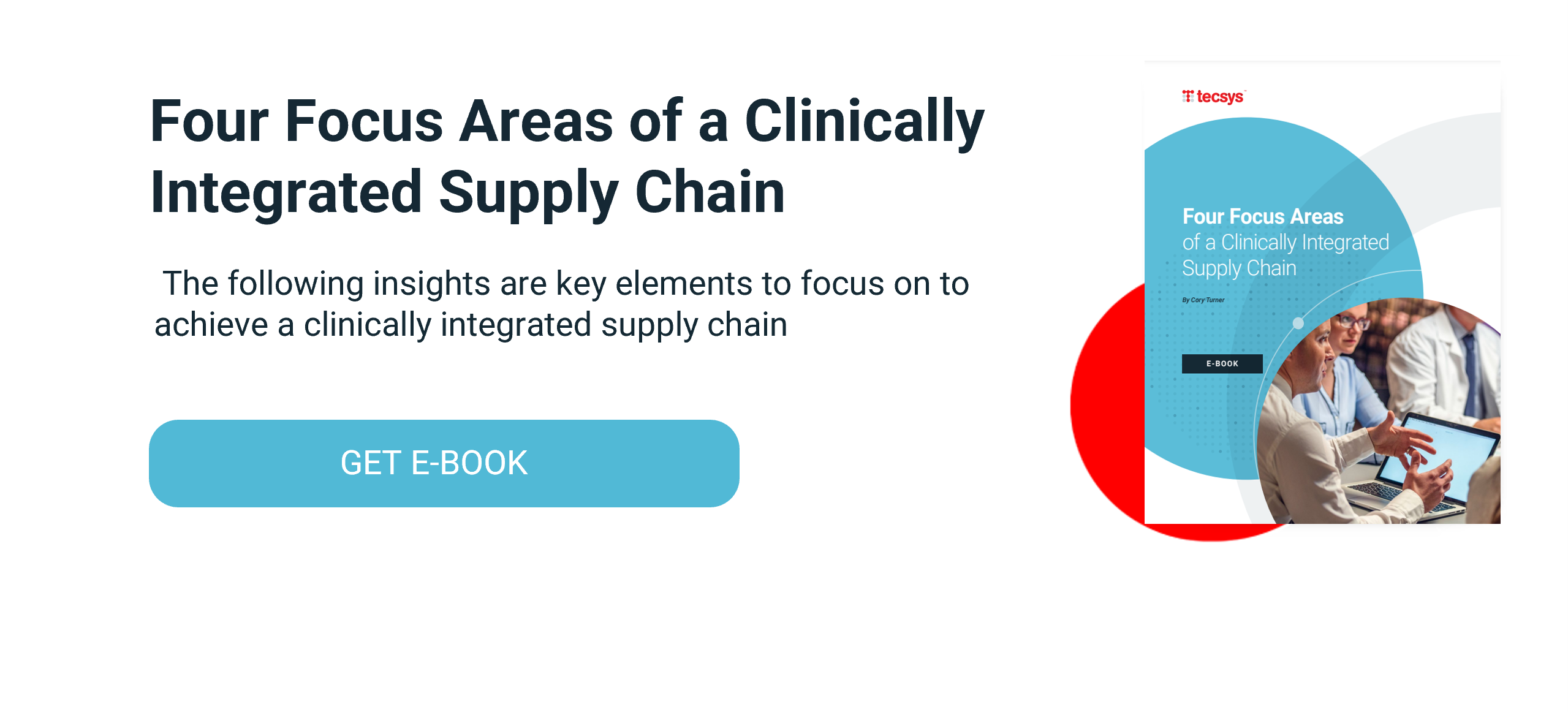Understand and Improve Utilization Management in Healthcare

Improving supply management and utilization management in healthcare doesn’t happen without technology. Clinical and supply chain system integration allows an organization to bring together the data needed to understand what supplies it is purchasing and using. Dashboards and analytics turn that data into actionable information to make informed strategic inventory management decisions.
What is Utilization Management in Healthcare?
Utilization management is the process by which healthcare organizations balance clinical and financial outcomes in product selection. If products with different price tags deliver the same clinical outcomes, the organization selects the lowest price item. This helps drive standardization, minimize variation in care delivery and lower costs while still putting the patients first.
While individual departments within a hospital (e.g., OR, Cath Lab) have deployed point of use (POU) inventory management systems to document product usage, the true value to an organization comes from end-to-end supply chain visibility and control.
There has been much talk over the past year about the need for greater healthcare supply chain resiliency. In order to achieve this, healthcare organizations need visibility and control over the entire scope of supply chain for medical supplies and pharmaceuticals — from procedural areas within a hospital, out through non-acute sites. This includes both owned and consigned supplies housed within facilities.
With a POU platform for inventory and utilization management in healthcare throughout the care continuum, the organization has a single source of truth for product demand and allocations. Through tight integration with the enterprise resource planning (ERP) and electronic health record (EHR) systems, supply chain leaders can access near real-time data on supply availability and usage for proactive decision-making.
5 Types of Utilization Management in Healthcare Through POU Inventory
1. Case Planning
Medical supplies and pharmaceuticals are a critical component of case planning. Case delays or cancellations caused by missing products at the point of care lead to clinician frustration, lost revenue for the organization and potentially patient harm.
Having accurate and timely visibility into product demand and allocations relieves staff from time-consuming logistics tasks while offering actionable information to take preventative actions. With68% of product disruptions being the result of poor demand signaling, operational transparency and cooperation can help with the success of healthcare case planning. Access to a single source of truth of inventory value and location can improve collaboration between clinical and supply chain stakeholders, physician preference card accuracy and patient care delivery.
2. Inventory and Case Cart Management
Supply chain teams and clinicians spend a great deal of time and effort locating the medical and pharmaceutical products needed for a case and getting them to the right places at the right times in the right quantities.
With a POU inventory management solution, supply chain can manage the optimization of inventory levels for appropriate case activity, handle case picking routes for faster picking without mistakes and automate the data capture of product usage during procedures. Additionally, they can assess demand based upon case schedules and optimize operating room (OR) physician preference cards driving fewer returns and urgent orders.
3. High-cost Specialty Items Management
Consignment inventory has long been a significant challenge for health systems as these products are typically managed outside of the ERP system. When these high-cost items (e.g., implants) are wasted, go missing or expire, the organization suffers sizeable financial losses.
With visibility across owned and consigned supplies, an organization can more effectively control its inventory and utilization management in healthcare, while achieving end-to-end traceability and chain of custody. POU supply data capture facilitates expiration and recall management, preventing safety issues and waste. It also streamlines reconciliation of invoices for bill-only/trunk stock items and automates purchase order (PO) generation.
4. Case Consumption Documentation
Accurately capturing product utilization at the POU supports both clinical and financial outcomes for healthcare organizations. Having a complete record of which products were used in which cases protects patient safety and facilitates charge capture, billing and reimbursement.
Integration of the POU inventory and utilization management system with the EHR supports seamless supply documentation. With single sign-on and user interface integration, clinicians can perform a single scan that accurately records case information within multiple applications (e.g., clinical, financial, operational). Through the system, they can also capture UDI effortlessly for intraoperative supply usage. This level of automation eliminates any double-entry processes to reduce the risk of erroneous input while providing real-time patient safety alerts.
5. Case Costing Analytics and Physician Preference Item (PPI) Standardization
To provide true value-based care — higher quality at a lower cost — a healthcare organization must know the complete cost of a case. Supplies are their second largest expense after labor; therefore, the true cost of care cannot be measured without them.
A POU inventory management system helps an organization achieve accurate case costing by capturing supplies as they are used on a patient. Integration of the system with the ERP and EHR facilitates the generation of advanced analytics on not only cost, but also patient outcomes tied to product usage. A healthcare organization can leverage this information for comparative effectiveness of products, as well as comparative performance of physicians. Based on utilization management data, it can use these insights to generate fact-driven recommendations on how to prevent financial waste and standardize on supplies to reduce variation.
Challenges in Utilization Management in Healthcare
1. Implementation
For healthcare organizations that already have a formal product review process in place, such as a value analysis committee or clinical review board, the implementation of a healthcare utilization management program is a natural next step in supporting value-based care delivery. Those that don’t should start by gaining C-suite support for the initiative because it will likely be a huge cultural change for both the clinical and supply chain teams. Having the right internal champions is critical to support this agenda.
2. Data Collection and Usage
Because a healthcare utilization management program relies heavily on data for product comparison (e.g., clinical effectiveness, safety, cost), access to accurate, complete and timely data is necessary. Without actionable data from all relevant systems (e.g., SCM, ERP, EHR), stakeholders can’t make evidence-based decisions.
3. Team Alignment
A healthcare organization where product purchases have always been driven by physician preference will face a tremendous cultural shift when pursuing a healthcare utilization management program. Therefore, there must be a concerted effort to foster collaboration among clinicians, supply chain and finance to achieve alignment on organizational goals (high quality/low costs). This again goes back to the need for internal champions who can rally these parties to action and data to make the case for change.
4. Technologies
To achieve interdepartmental collaboration and acquire data to drive change, a healthcare organization needs a fully integrated, end-to-end, electronic technology infrastructure. Without it, the healthcare utilization management program will be stuck relying on error-prone and inefficient manual processes and Excel spreadsheets for data collection and analysis. The ideal three-platform approach is integration among the organization’s supply chain management (SCM), enterprise resource planning (ERP) and electronic health record (EHR) systems.
Conclusion
By implementing an efficient inventory system, you can alleviate stress-induced processes among your clinical staff and improve inventory management. The assessment of previous and current supply usage also advances product knowledge about utilization management in healthcare and better prepares clinicians for future action.
A holistic approach based on the three key platforms – SCM, ERP and EHR – with the SCM replacing redundant bolt-on systems for supply management in clinical areas, streamlines the product review process and speeds time to value. The healthcare organization has immediate access to accurate and actionable cost, quality and outcomes data for products throughout the care continuum.
The delivery of care is continuously expanding beyond the hospital and into the communities. When selecting an inventory system, ensure it can support both acute and non-acute sites so that you can get the full picture of your organization’s supply purchases, management and use.




